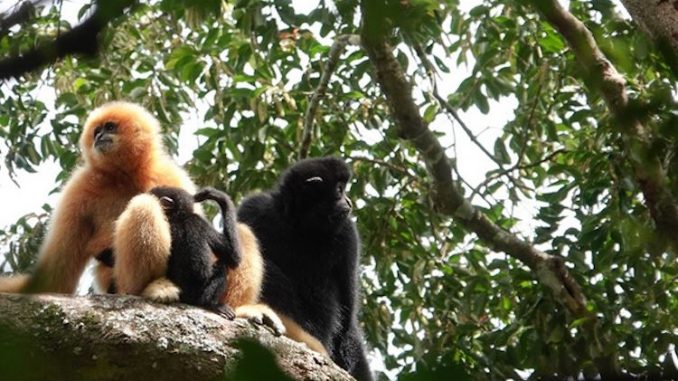
Many species on Earth are currently threatened by environmental problems and human activities. According to Dahua, technology is increasingly being used as an innovative way to promote sustainability and biodiversity conservation.
Hainan gibbons (Nomascus hainanus) live in the Bawangling National Nature Reserve on the island province of Hainan, off the coast of southern China. They are listed as “critically endangered” by the International Union for Conservation of Nature (IUCN), with less than 10 left back in the 1980s.
Over decades of protection, the number of Hainan gibbons has grown to 37 individuals in five populations. Dahua joined in on the Hainan gibbon protection project in 2021, offering smart video technology to improve the monitoring efficiency of the reserve and assist in local biodiversity protection.
Monitoring gibbons used to be a challenge
As lifelong arboreal animals, Hainan gibbons are hard to spot in dense forests. “In the beginning, they ran as soon as they saw me. After a long time, we can gradually ‘communicate’, especially the newborn cubs. We go up and wave every day. After a few years, we got along well, and it even came straight to us,” said monitoring staff member Mr Zhang.
Being able to monitor gibbons is gratifying but the process is often exhausting. They move fast, sometimes too fast for the naked eye to follow. In order to keep up with the gibbons, monitors often miss meals and suffer from stomach problems. Bad weather, such as rain, thunder and even typhoons, can worsen things.
Smart “eyes” enabled by video technology
The introduction of technology has resolved this; smart cameras that can quickly identify gibbons and take pictures, allowing monitors to observe these creatures up close without disturbing them.
With the help of smart cameras, the gibbons appear more clearly on video than previously with the naked eye. “The gibbon itself is hard to spot in the trees, and they are highly vigilant when approached by people. The camera lens perfectly solved this problem,” said Zhang.
To make it easier for the monitors to ‘chase’ the gibbons, Dahua has integrated a highly-sensitive motion algorithm into the smart camera. The algorithm is trained continuously through the Dahua AI platform to accurately identify and collect images of fast-moving gibbons based on the gibbon’s hair colour, movements, habits, etc., to provide a scientific basis for the study of individuals, populations, age, sex, developmental trends, and dynamic changes in habitats.
Dahua and biodiversity protection
Dahua has been using digital and intelligent technologies to promote sustainability and biodiversity protection in sanctuaries across the globe.
In Schwarze Berge (Black Mountains) Wildlife Park located in Germany, a series of Dahua cameras equipped with technologies such as full-colour and thermal imaging, help the park monitor the living environment and health status of wild animals without disturbing them. The solution also helps improve the park operate more efficiently.
Dahua has also established a 5G digital monitoring system to help Baima Snow Mountain Nature Reserve monitor 62 species of wildlife, providing accurate observation and research assessment of wildlife, ecological types and biodiversity in the reserve. The system is able to calculate animal population, analyse their activity patterns, understand their living habits, and detect illegal activities in the reserve, such as poaching, illegal logging, and overgrazing.
In addition, Dahua entered the Antarctic region for the first time by donating 15 intelligent devices to various scientific bases. Providing clear images of flora and fauna in the Argentine region of Antarctica is beneficial in the research studies conducted on “The White Continent.”





